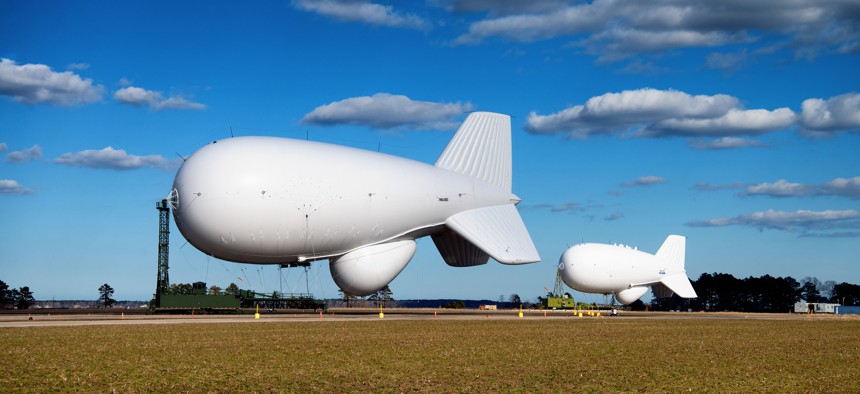
JLENS aerostats docked at Weeksville NC, Dirigible Hangar. Flickr image via Bill Dickinson
JLENS Supporters: Never Mind the Blimp, Save the Radar
The super-sophisticated sensor remains America’s best near-term defense against Russian cruise missiles, retired brass argue.
A group of retired admirals and generals who spent much of their careers specializing in missile defense threw their support behind the troubled JLENS air-defense system whose aerostat broke free of its Maryland mooring and floated more than 100 miles north to Pennsylvania in October.
They say the JLENS radar is a key defense against Russian cruise missiles like the 26 fired in October from Russian warships in the Caspian Sea at Syrian targets more than a thousand miles distant.
“The cruise missile challenge from more near-peer competitors is very real,” Kenneth Todorov, a retired Air Force brigadier general who was most recently deputy director of the Missile Defense Agency, the arm of the Pentagon that oversees all missile defense projects. “It comes with little warning, should it come. We as a nation are right now not particularly well-equipped to identify, to gage intent and to complete the kill chain on that.”
The Syria strikes marked the first combat use of the Kalibr cruise missiles, said Archer Macy, a retired rear admiral and former director of the Joint Integrated Air and Missile Defense Organization.
“We have long known that the Russians have had cruise missiles,” Macy said. “This was their first opportunity to use them and they we’re making a point.”
The U.S. military first used Tomahawk cruise missiles during Desert Storm in 1991. “People knew the U.S. had had it, but there was shock and awe at what was accomplished by the Tomahawk,” Macy said.
JLENS, which stands for Joint Land Attack Cruise Missile Defense Elevated Netted Sensor System, is designed to spot low-flying cruise missiles and smaller weapons, such as drones. The system includes two aerostats floating at 10,000 feet and bearing powerful radars affixed to their underbellies. Supporters say they can detect incoming threats flying too low for ground-based radars to pick them up.
The blimp that broke free was less than a year into a three-year test project. Military officials have been considering using JLENS as part of a network to protect cities across the U.S. from cruise missiles. The Army suspended the project after the October incident, but it still has it supporters both on Capitol Hill and close to the military.
“I love the capability that it brings, [but] I don’t really love the platform that it’s brought on,” Todorov said of the JLENS Friday at a Center for Strategic and International Studies event.
“The platform is not great, but let’s not focus on the platform. Let’s focus on the capabilities that are brought by the platform,” he said. “Let’s restart that test and let the warfighter tell us how effective [it is].”
Todorov said other options include putting the radar on an orbiting satellite or long-endurance drone.
The U.S. Army is still investigating how the massive aerostat, which is nearly the size of a football field, broke free of its mooring.




